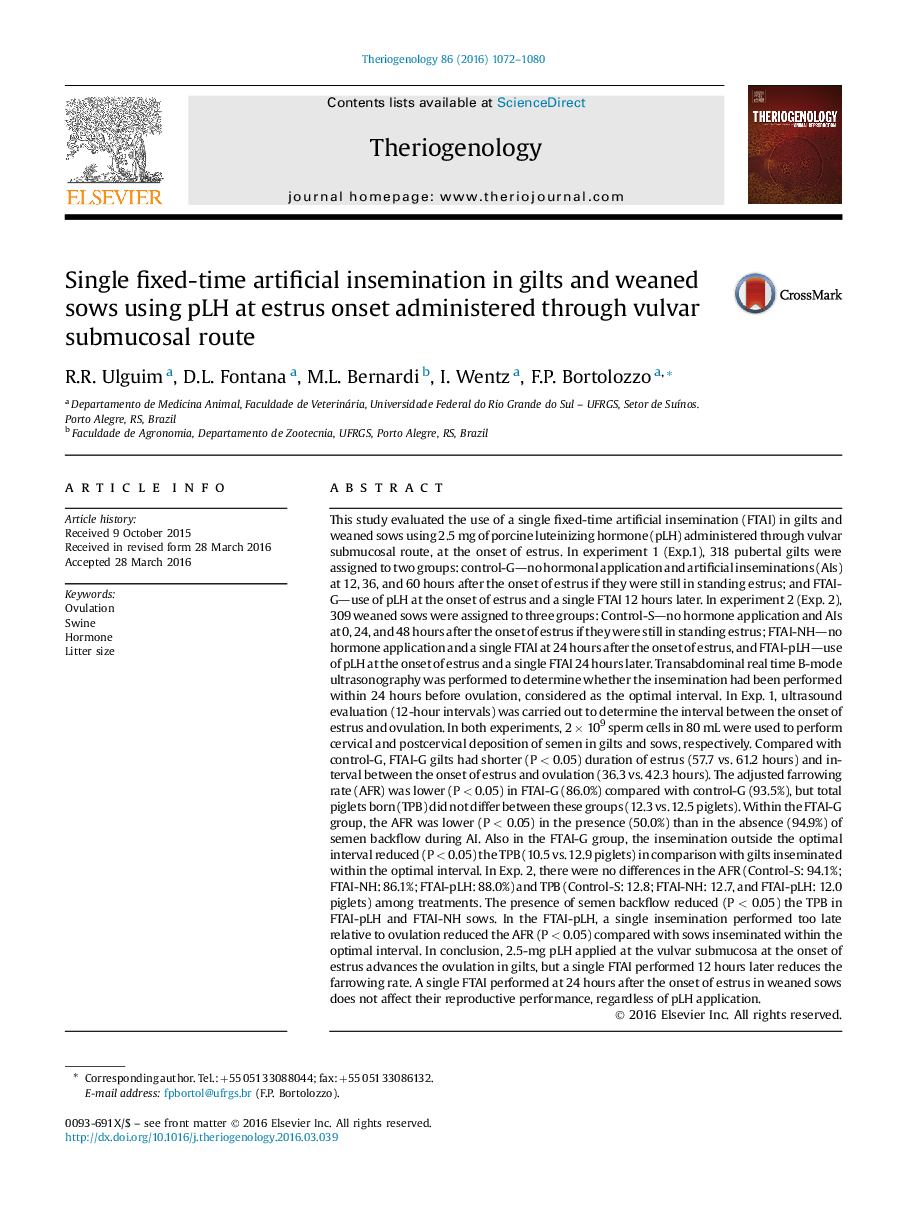| کد مقاله | کد نشریه | سال انتشار | مقاله انگلیسی | نسخه تمام متن |
|---|---|---|---|---|
| 2094732 | 1082049 | 2016 | 9 صفحه PDF | دانلود رایگان |
This study evaluated the use of a single fixed-time artificial insemination (FTAI) in gilts and weaned sows using 2.5 mg of porcine luteinizing hormone (pLH) administered through vulvar submucosal route, at the onset of estrus. In experiment 1 (Exp.1), 318 pubertal gilts were assigned to two groups: control-G—no hormonal application and artificial inseminations (AIs) at 12, 36, and 60 hours after the onset of estrus if they were still in standing estrus; and FTAI-G—use of pLH at the onset of estrus and a single FTAI 12 hours later. In experiment 2 (Exp. 2), 309 weaned sows were assigned to three groups: Control-S—no hormone application and AIs at 0, 24, and 48 hours after the onset of estrus if they were still in standing estrus; FTAI-NH—no hormone application and a single FTAI at 24 hours after the onset of estrus, and FTAI-pLH—use of pLH at the onset of estrus and a single FTAI 24 hours later. Transabdominal real time B-mode ultrasonography was performed to determine whether the insemination had been performed within 24 hours before ovulation, considered as the optimal interval. In Exp. 1, ultrasound evaluation (12-hour intervals) was carried out to determine the interval between the onset of estrus and ovulation. In both experiments, 2 × 109 sperm cells in 80 mL were used to perform cervical and postcervical deposition of semen in gilts and sows, respectively. Compared with control-G, FTAI-G gilts had shorter (P < 0.05) duration of estrus (57.7 vs. 61.2 hours) and interval between the onset of estrus and ovulation (36.3 vs. 42.3 hours). The adjusted farrowing rate (AFR) was lower (P < 0.05) in FTAI-G (86.0%) compared with control-G (93.5%), but total piglets born (TPB) did not differ between these groups (12.3 vs. 12.5 piglets). Within the FTAI-G group, the AFR was lower (P < 0.05) in the presence (50.0%) than in the absence (94.9%) of semen backflow during AI. Also in the FTAI-G group, the insemination outside the optimal interval reduced (P < 0.05) the TPB (10.5 vs. 12.9 piglets) in comparison with gilts inseminated within the optimal interval. In Exp. 2, there were no differences in the AFR (Control-S: 94.1%; FTAI-NH: 86.1%; FTAI-pLH: 88.0%) and TPB (Control-S: 12.8; FTAI-NH: 12.7, and FTAI-pLH: 12.0 piglets) among treatments. The presence of semen backflow reduced (P < 0.05) the TPB in FTAI-pLH and FTAI-NH sows. In the FTAI-pLH, a single insemination performed too late relative to ovulation reduced the AFR (P < 0.05) compared with sows inseminated within the optimal interval. In conclusion, 2.5-mg pLH applied at the vulvar submucosa at the onset of estrus advances the ovulation in gilts, but a single FTAI performed 12 hours later reduces the farrowing rate. A single FTAI performed at 24 hours after the onset of estrus in weaned sows does not affect their reproductive performance, regardless of pLH application.
Journal: Theriogenology - Volume 86, Issue 4, 1 September 2016, Pages 1072–1080
